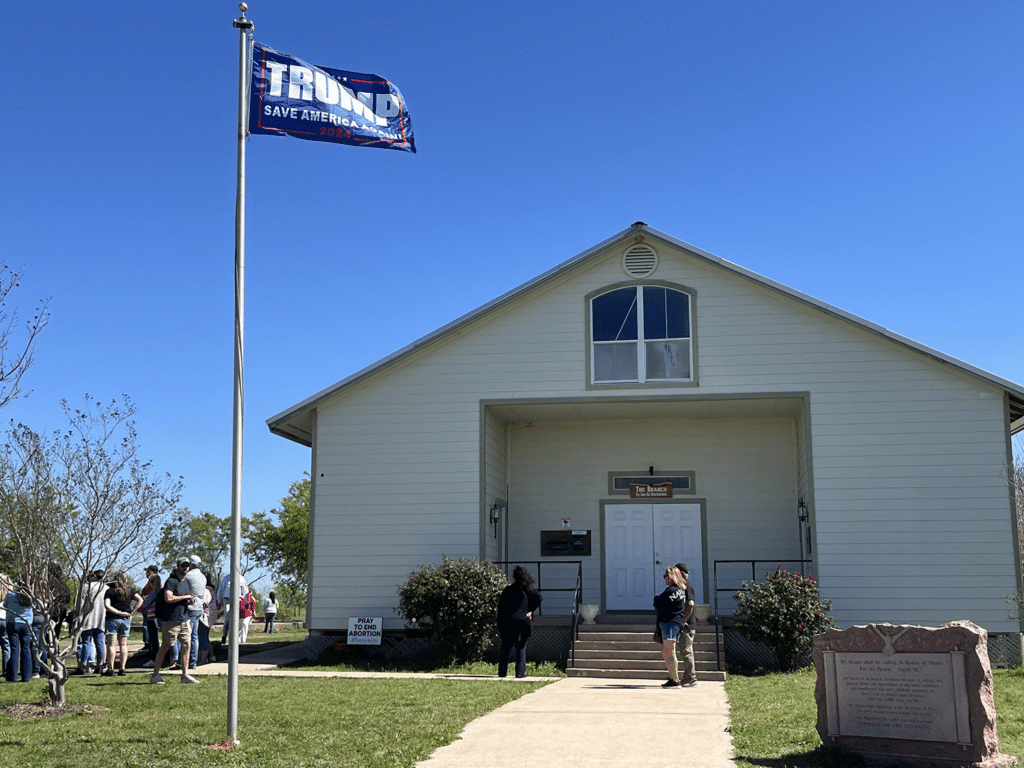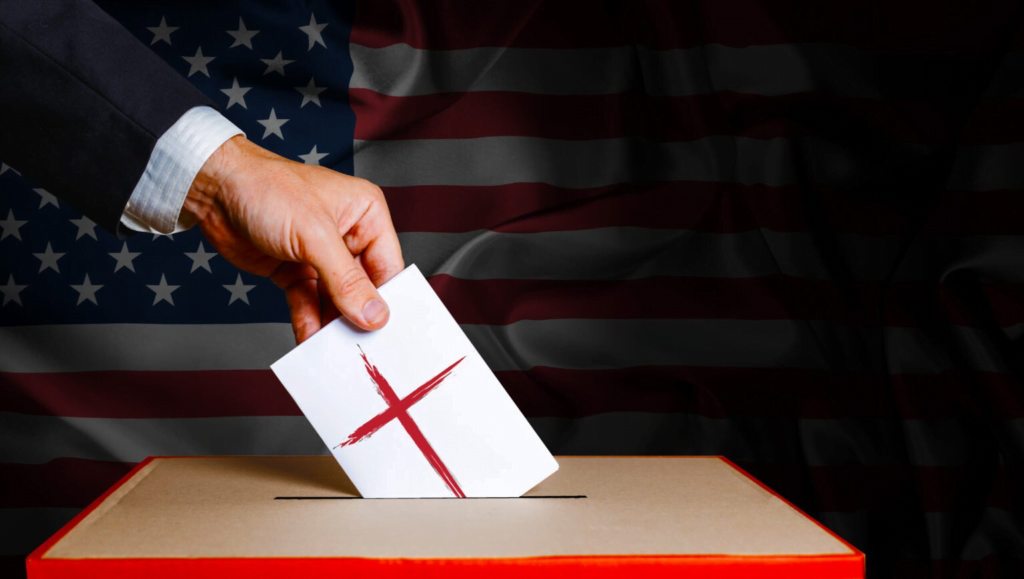The road to the Waco, Texas, airport was littered with tents called patriot stores selling MAGA merchandise last Saturday. They had been out since Wednesday in preparation for Donald Trump’s rally. Trump 2024 flags flew next to Confederate flags, “F*** Biden” flags, Gonzales flags with “Come and Take It” written under an AK-47 and flags that read “Jesus is my Savior, Trump is my President.”
Thousands attended the Trump rally Saturday in the town known by eclectic identifiers. Many tourists who visit Waco come for Baylor University or Chip and Joanna Gaines’ Magnolia empire. But it is also a place of pilgrimage for members of the far-right.
READ: With God On Their Side? White Christian Nationalists’ Crusade Against Multiracial Democracy
Thirty years ago, tragedy and violence put Waco on the map during the 51-day standoff between law enforcement and a religious compound resulting in the deaths of 82 Branch Davidians and four federal agents.
The Branch Davidians
The Branch Davidians are a doomsday new religious movement with a complicated history as a Christian sect. They split from a group in the 1950s that split off from the Seventh-day Adventists in the mid-1930s. The sect’s history is full of divisions and the frequent changing of leadership, sometimes by force.
Its most famous leader, David Koresh, rose to power at the Waco compound in 1987, bringing with him ideas that he was the messiah and a descendent of the biblical David and Cyrus the Great. Under his short reign, he took several “wives,” including underage girls, and encouraged his followers to prepare for the end times.
In 1993, the Bureau of Alcohol, Tobacco, Firearms and Explosives attempted to raid the compound due to a stockpiling of weapons there. The raid resulted in gunfire, killing six Branch Davidians and four agents. The Federal Bureau of Investigation took over in a weeks-long standoff that ended in a fire — the origins of which are debated — killing another 76, including Koresh.
Birth of a movement
In the aftermath, the media and the public largely viewed this event as a tragedy within a fringe cult. But for some, the agents’ actions were evidence of a federal siege of unlawful overreach, a parable of what happens when the government has too much power.
“For right-wing militias and so-called Patriot groups, Waco amounts to evidence of a tyrannical, illegitimate government unblinkingly prepared to kill its own people,” writes journalist Clyde Haberman.
Historians frequently cite the Branch Davidian siege as the inciting incident that birthed the popularization of militia and patriot movements. Once-fringe groups used the raid as a rallying cry to legitimize their beliefs, as the far-right started to move into the mainstream of American culture.
After Waco, “the militia movement surged to more than 50,000 members in 47 states and focused increasingly on taking violent action to stop the rampant federal government,” writes extremism historian Kathleen Belew.
Waco has remained a beacon for far-right Americans, an important lesson in history of the government’s ability to overstep its authority. “The specter of Waco has not faded. Right-wing extremists regularly invoke it as a defining moment, proof of Washington’s perfidy,” writes Haberman.
The 1995 Oklahoma City bombing happened on the two-year anniversary of the Waco raid, and Timothy McVeigh claimed his violence was a direct response to Waco. In 2009, the Three Percenter founder threatened, “No more free Wacos.” And one of the January 6 rioters called the insurrectionists’ struggle with police “Waco 2.0.”
Coincidence or not?
With this history in mind, it is likely no coincidence Trump scheduled his first 2024 presidential campaign rally in Waco during the 30th anniversary of the raid on the Branch Davidian compound.
In typical Trump fashion, his speech on Saturday was full of fearmongering and painting himself as the victim of governmental “abuses of power” in regard to his recent legal troubles. He extended his victimhood to his fans saying: “They’re not coming after me. They’re coming after you.”
Trump aides claimed the choice of the rally’s timing and location are unrelated to the infamous raid. However, Trump’s speech of victimhood and governmental “abuses of power” are eerily similar to the far-right’s rhetoric surrounding the raid, which identify Koresh and his followers as the victims of federal overreach.
Today, there is still a small constituency of about a dozen Branch Davidians in Waco as well as a few thousand outside the city. In recent years, the current leader in Waco, Charles Pace, has adopted QAnon-like beliefs about a governmental deep state.
Pace’s eBook about the prophecies and beliefs of the current group reads like an apocalyptic comic book of conspiracy theories, claiming Trump was anointed by God with the ability to bring about the end times. The book features an image of Trump’s face super-imposed over Cyrus the Great — an Old Testament character who was not Jewish but used by God.
Trump flag at the compound

Currently, the compound is a memorial to those who died and a shrine to Trump. Shortly past the gate onto the compound stands a memorial with a stone for each Branch Davidian who died in 1993 with two massive Trump 2024 flags flying on the corners of the monument.
The main structure on the property is a simple white chapel, where another Trump flag is flying above a “Pray to End Abortion” sign on the lawn. Inside, the walls are covered with pictures from the raid and the fire, a “don’t trust the government” sign and images of those who died with the title of “martyr” over their names. There are posters and whiteboards with prophecies involving Koresh as well as newer Q-Anon-inspired conspiracies. Shirts for sale are pinned on the walls with pro-Trump messages, anti-Biden messages and images of Koresh holding a gun and saying, “I will meet you at my door anytime.”
Speaking about the extremist groups who make pilgrimages to the compound, Pace said: “The Holy Spirit leads them here. The Proud Boys were here, about 30 of them. They say Waco is the Alamo of the modern Patriot movement. I told them, ‘If David Koresh were here today, he’d be one of you.’”
While far-right members are frequent visitors, these pilgrimages are not just for radicals and are becoming more mainstream for curiosity-seekers. Despite the extremist views in the chapel and those spouted from Pace, the compound remains a place of pilgrimage for many who disagree with these religious views.
On the morning of the Trump rally, 50 or so MAGA supporters visited the compound before going to the airport to hear his speech.
Connie Rainbolt, 75, who touched her cross necklace when she said she was a Christian, is a Trump supporter who does not agree with the beliefs of the Branch Davidians but came to the compound the morning of the rally out of curiosity.
“I really never paid that much attention to (the Branch Davidians) to know exactly what they did believe. I just know that what (Koresh) was doing was wrong. You don’t molest children,” Rainbolt said. “But other than that, I mean it’s beautiful out here. … This is like one of the things that is evil but yet peaceful.”
Many pilgrims don’t agree with the beliefs of the Branch Davidians, but they come to the compound with the same sense of curiosity. And while they disapprove of the abuse and the conspiratorial specifics, some Christians share with Branch Davidians the idea that God has a preference for Trump and has anointed him to save America.
One rally attendant, Lindy-Ann Hopley, told the Washington Post, “I’m here because God gave me a dream that revival is coming to America. The hand of God is on (Trump).”
Christian nationalism

The increasingly popular view that Trump was chosen by God points to a trend toward Christian nationalism, which shares with far-right groups a distrust of the government.
“Waco is hugely symbolic on the far-right,” said Heidi Beirich, co-founder of the Global Project Against Hate and Extremism. “There’s not really another place in the U.S. that you could pick that would tap into these deep veins of anti-government hatred — Christian nationalist skepticism of the government.”
Like the militia movements, the concept of Christian nationalism is built on the rubble of fear and the perception that a way of life is under attack and therefore needs to be defended. Christian nationalists carry a similar fear that if the church does not have leadership over the government, then the government will suppress the beliefs and freedom of the church. This kind of perceived victimhood frequently results in defensive posturing even to the point of violence.
READ: Christianity Will Fail If We Don’t Stop Christian Nationalism
In the last presidential election, Trump took advantage of the popularization of Christian nationalist ideas with the Bible-holding photo-op in Lafayette Square in Washington and photo-ops of pastors laying hands on him in the Oval Office.
In recent days, “as state and federal investigations have drawn closer to him in recent months, he has often portrayed himself in embattled or even apocalyptic terms,” writes journalist Charles Homans. “In a speech at the Conservative Political Action Coalition conference this month, he described the 2024 presidential election as ‘the final battle’ and vowed ‘retribution.’”
In the upcoming election, Trump likely will continue to push the scare tactics of apocalyptic rhetoric along with Christian nationalist and far-right ideas in order to appeal to his base.
Perhaps the timing and location choice of Trump’s first 2024 presidential rally really was a mere coincidence with the 30th anniversary of the Branch Davidian raid. But there are undeniably troubling connections between the rhetoric of a fringe religious sect and Patriot groups, Trump’s victimhood in his Saturday speech and the Christian nationalism in his constituency.
After Trump’s first official 2024 campaign stop, it’s difficult to overlook the reality that extremist views are leaking into mainstream American culture and Christianity.
This article was originally published at Baptist Global News, a reader-supported, independent news organization providing original and curated news, opinion and analysis about matters of faith. You can sign up for their newsletter here. Republished with permission.







